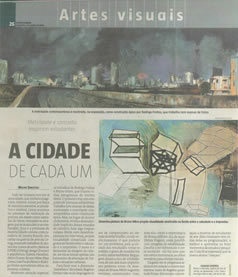
Every human being has a city that, although imaginary, within, exists by ancestral memory force, cumulative and residual. Similar to what happens in the process of painting, it exists through layers of paint becoming images that accumulate and blend. Such is the premise of the showing Visible Cities, with the curatorship by Sandra Bianchi, now showing at the Cemig art gallery, combining works of students from fine arts (UFMG and UEMG), design (Fumec) and architecture (Isabela Hendrix).
Altivo Duarte, Bruno Mitre, Elisa Grossi, José Paulo Neves e Rodrigo Freitas present works, accurate, to say the least.
The works of Rodrigo Freitas e Bruno Mitre deserve special attention for bringing antagonic views from the elected motive. The first brings a compound of admirable paintings. He works with masses of paint, showing the contemporary metropolis as an epic construction. Instead of a civilization praise, he reveals the implicit dramatics within these concrete worlds, which are today, crepuscular. Mitre, and his drawing-paintings (or vice-versa), offers constructed visuals with gestures border lining calculated and improvised. His motto is disassembling the image of the city until it becomes only a beating of evoking shapes and urban situations.
In order to make the city dimension sound "metaphysical", Rogerio Freitas takes up the words (and compositions) of the German Anselm Kieffer. What could be a problem, for the amount of work, becomes merit: it is very bold for a young author to confront a language so deep, rich and full of symbolism by one of the most important painters alive. Bruno Mitre's drawings suggests terrains, constructions, streets, but embody the experience of imbalance (or fragile balance), pointing out images of stability. The challenge to be faced is such oscillation – which causes in certain times the works to slip to visual effects.
It is gratifying to see the artistic progress comparing to other moments of Rogerio as well as Bruno. On a further ado: about students' art showings (Belo Horizonte has many of the programmed), the best is thing to do is enjoy the good moments of studies and researches and not to wait for the youngsters to "grow".
Minas Gerais
Friday, October 7th, 2005.
Walter Sebastião

